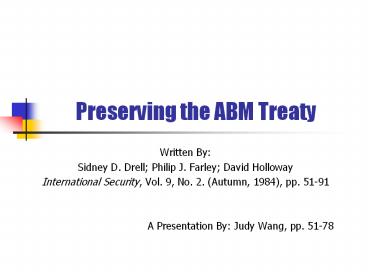Preserving the ABM Treaty PowerPoint PPT Presentation
Title: Preserving the ABM Treaty
1
Preserving the ABM Treaty
- Written By
- Sidney D. Drell Philip J. Farley David Holloway
- International Security, Vol. 9, No. 2. (Autumn,
1984), pp. 51-91 - A Presentation By Judy Wang, pp. 51-78
2
The Case against Missile Defense
- Futile Offensive missiles would prevail in a
competition - Costly Maintain deterrent threat
- Destabilizing Speed up arms race
- -compete to build defensive system
- -come to build offensive missiles to overcome
opponents defensive system - -pressure to strike first (fear other sides
defensive capabilities)
3
Preventing War and Reaching a Common Goal
- Other Measures besides ABM Treaty
- 1971 agreement on hotline reduce risk of
accidental war by allowing leaders to communicate
during crises - 1973 agreement to prevent nuclear war and to act
to avoid a nuclear war during crises - Agreed to ABM Treaty in 1972 to avoid nuclear
war and its devastating consequences for all
mankind - -accepts deterrence as a necessary condition
instead of as a threat - Self-deterrence suicidal for any country to
start a nuclear war - Does self-deterrence still apply today? Does it
apply to rogue states? If self deterrence works,
why fear a nuclear threat at all?
4
About the ABM Treaty and Reagan
- Article V.1 each party undertakes not to
develop, test, or deploy ABM systems or
components which are sea-based, air-based,
space-based, or mobile land-based. - Vague on purpose so as not to rule out other
devices that can be developed in the future. As
long as treaty is amended, these devices are not
exempt. - Reagan, March 23, 1984 Wants to build a
Strategic Defense Initiative (SDI) - Escape from reliance on mutual deterrence, but
interim goal is to enhance deterrence - 1985-1989 a cost of 26 billion dollars
- Says it is consistent with ABM.for now
5
The Soviet Perspective
- Late 1960s, Soviets began to doubt effectiveness
of ABM systems. - Increased confidence in deterrence, realized that
both sides vulnerable to a devastating
retaliatory strike if it attacked first. - Desired ABM Treaty b/c without it
- Upset the nuclear balance
- Lead to an unconstrained race in ABM systems and
the further deployment of offensive forces - Not effective vs. offensive missiles
6
- View U.S. weapons program as a way to gain
strategic superiority. - Criticized Reagans speech as a way for the U.S.
to undermine its commitment of making progress in
limiting and reducing offensive weapons - Serious Threat and Rejection of ABM Treaty
- Soviets would respond by building their own
7
Soviet Activities
- Soviets still focus on how to wage a war and
defeat the enemy - Soviet Activities in ABM technologies
- Upgrading the Moscow ABM system, fully
operational since 1970 or 1971 - Replace Galosh interceptor missiles with SH-04
and SH-08 nuclear-armed missiles (allows them to
use atmospheric sorting to differentiate between
real vehicles and ecoys) - New phased-array radars to complement missile
detection
8
Soviet Activities (cont)
- SH-04 and SH-08 could be used to create a
nationwide defense - Building a radar that fills a gap in the Soviet
early warning system, claim the radar is designed
for space tracking and thus, consistent with the
Treaty - Surface-to air missiles (SAMs) improved
capability to deal with smaller radar cross
sections and shorten reaction times - SA-12?reported to have been tested vs. ballistic
missile reentry vehicles, a violation of Article
VI.a of the ABM Treaty. - No concrete evidence that Soviets will pull out
of ABM Treaty
9
Missile Defenses
- Space-Based Chemical Lasers
- Can travel the speed of light in space above the
atmosphere - Complex, expensive, vulnerable to attack,
effective countermeasures, must function above
atmosphere. - Complexity of defense system page 68.
- Three Layer Defense system, if 90 effective,
would allow only 8 out of 8,000 to arrive on
target - Other weaknesses
- Vulnerable to direct enemy attack with space
mines - Countermeasures such as disruption of operations,
like sensors and communication links, would
render it inoperable. - Decoys
10
Pop-up systems
- X-ray lasers, driven by nuclear explosives and
mounted onto a missile that can be launched
rapidly. - Idea is to mount this system on a rocket to be
boosted into space upon detection of a missile
attack - Most important conflict is if the system can be
deployed rapidly enough to attempt a boost-phase
intercept - Must be based near Soviet territory due to the
shape of the Earth - Countermeasures
- High-thrust hot missiles that burn below the
top of the atmosphere - Alter trajectory of launch
11
Hybrid System
- Ground-based lasers whose beams are aimed up to a
small number of large relay mirrors that then
direct the beams to mission mirrors, which then
redirect the beams onto their targets. - Fewer parts in orbit that space-based system,
avoids time constraint of pop-up - Unavoidable technical and operational problems
- Vulnerable to attack
12
Mid-Course Intercept and Battle Management
- Target the post-boost vehicles, then target the
individual warheads. - Generally harder to target smaller
- Warheads are smaller and harder still and more
numerouscan also dispense light decoys, which
follow the same path - Can confuse sensors with anti-simulation (making
warheads look like decoys) - No real viable defense
13
Terminal Defense
- No prospect for defending the nation against a
massive attack - Easier to do b/c of recent technological
advances, and b/c the goal is to destroy enough
warheads to cause the attacker to expend more of
his force than he destroys

